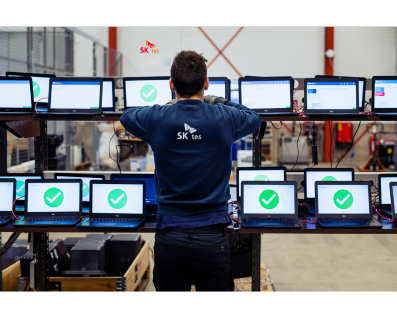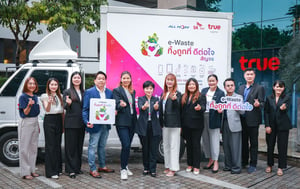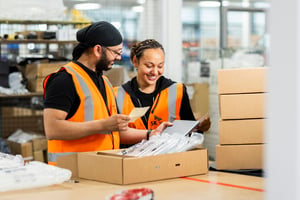The challenges and learnings from implementing sustainability practices in the e waste recycling industry.
Electronics recycling is crucial for environmental sustainability and human health. E-waste contains hazardous materials that can pollute soil and water. Recovering non-renewable resources like gold, silver, and copper reduces the need for new mining. Proper e-waste management also eliminates air and water pollution that can harm both humans and the environment. Extending the lifecycle of technology, recycling electronics, and recovering their materials reduces the carbon footprint of the electronics industry and promotes ethical responsibility.
Implementing sustainable practices in any business is a challenge that requires significant effort and commitment. From the beginning with feelings of loneliness, it can be difficult to find a community of like-minded individuals who share the same values and goals, through to encountering knowledge gaps or resistance, which can hinder progress towards sustainability. This blog post chronicles SK Tes's progress on the path towards sustainability, to offer guidance and inspiration to those working through their sustainability journeys.
It can be challenging to balance commercial interests with environmental, social and governance (ESG) impacts. Even more so, when considering the time to prioritize sustainability without sacrificing profitability. However, it is important to recognize that sustainability can lead to long-term financial benefits for businesses. Being reactive rather than proactive is another common challenge. Many businesses only focus on sustainability and ESG after a crisis or negative event occurs. It is important to be proactive and anticipate potential issues before they arise.
6 Lessons for Implementing Sustainability and ESG Strategies, SK Tes example:
1. Point to the business reason and urgency
Use scientific data, facts, and legislative direction to inform and communicate the why. Reasons such as regulatory compliance, competitive advantage, attracting investment, satisfying customers, achieving operational efficiencies, employee satisfaction and more will trigger support from various stakeholders.
The scale of the challenge is also daunting, as it requires significant changes in business practices and culture. Implementation of technology can help facilitate sustainability efforts, but it can also be a challenge to integrate new tools and systems into existing operations.
2. Your ESG system and reporting grows with you
Automation, customization and integration are critical. Systems are extensible and not limiting, look for technology providers who give good ongoing account management and support implementation.
Practical constraints of working across multiple countries and languages can also pose difficulties in implementing sustainable practices. SK Tes operates over 40 facilities across 23 countries worldwide, and our employees speak even more languages than that and our compliance landscape is highly complex. However, with perseverance and collaboration, these challenges can be overcome, and businesses can move towards a more sustainable future.
3. Spread the load with your team
It’s impossible to be everywhere all the time, call for volunteers and engage with individuals and teams that show interest and enthusiasm. Create local sustainability champions to support efforts and implementation around the world.
SK Tes is a global industry leader in IT asset disposition services and e waste recycling with a strong focus on sustainable business practices. From day one, our business model has been inherently sustainable. However, in 2018, SK Tes began targeted efforts to implement sustainable practices, including disclosing ESG efforts and GHG emissions reporting.
In 2020, SK Tes leadership established a sustainability vision and mission, which was further developed to include 17 Sustainable Impact Goals aligned with the UN SDGs in 2022. SK Tes made a commitment to science-based targets for scopes 1,2 and 3 GHG emissions which were accepted by SBTi. Additionally, SK Tes received its first EcoVadis sustainability rating and began disclosing climate risk and opportunities reporting. For more about SK Tes achieving EcoVadis Gold rating in 2024, read more here.
Moving into 2024, SK Tes continues its focus on climate transition plans. Overall, we are committed to ensuring that they remain at the forefront of sustainable business practices and continue to make a positive impact on the environment. Implementing sustainable business practices is not always easy, and requires a careful balance of managing risks, promoting benefits, and embracing change.
One of the biggest challenges of implementing sustainable business practices is managing the risks associated with such practices. For example, implementing renewable energy sources may require significant upfront investments, and there may be uncertainty around the long-term benefits of such investments. However, by carefully assessing the risks and developing risk management strategies, companies can minimize the potential negative impacts of sustainable practices.
Another important aspect of implementing sustainable business practices is promoting the benefits. By highlighting the positive impacts of sustainable practices, companies can generate support from stakeholders and create a culture of sustainability within the organization. This can lead to increased employee engagement, improved brand reputation, and enhanced customer loyalty.
4. It’s a sales job - to get stakeholders on the sustainability journey
You need to convince people to come with you on the journey. Pitch communications appropriately and tailor information to appeal to your audience. Talk in their language and address opportunities and pain points.
Finally, implementing sustainable business practices requires embracing change. This may involve rethinking traditional business models, adopting new technologies, and collaborating with stakeholders to find innovative solutions to sustainability challenges. While change can be difficult, it is essential for companies that want to remain competitive and relevant in today's rapidly changing business environment.
5. Have a strategy to help with effective change management
Successful change management is crucial for any organization's growth and development. It's a process that involves planning, implementing, and evaluating organizational changes.
Here are 5 strategies to help ensure effective change management:
-
Align vision and values - Subscribe all stakeholders to a common and worthwhile purpose
-
Engage and empower stakeholders - Learn effective strategies for engaging stakeholders and gaining their support in driving sustainable change
- Training Education and Adaptation - Explore the importance of providing training and education to equip employees with the knowledge and skills needed for sustainable practices
- Communicate and inspire - Discover the power of clear and impactful communication in ensuring successful change management in electronics recycling.
- Measure and monitor outcomes - Establish clear metrics and KPIs to measure change. Regularly monitor progress and adjust strategy as necessary. Share results to maintain transparency and trust.
SK Tes's sustainability journey has been a fruitful one, and we've learned that effective communication, data analysis, and action are all necessary components to achieve our goals and make progress. The diagram that we've created to showcase this illustrates the overlap between these three elements and how they have helped us to deliver on our sustainability objectives.

Communication is an essential part of any sustainability initiative. By communicating our goals and objectives to our stakeholders, we can create a shared vision and commitment to sustainability. We have found that clear and transparent communication is essential in building trust and credibility with our stakeholders.
6. Communicate, communicate, communicate about Sustainability & ESG efforts and engage customers and partners
Partner and engage with all stakeholders to build momentum.
Data analysis is another crucial component of our sustainability journey. By collecting and analysing data, we can identify areas where we can improve our sustainability performance. We use data to track our progress and measure our impact, which helps us to make informed decisions about where to focus our efforts.
Implementing sustainable business practices is crucial for the long-term success of any organization. The electronics recycling industry, in particular, plays a vital role in environmental sustainability and human health. While implementing sustainable practices can be challenging, it is important to balance commercial interests with ESG impacts, communicate effectively with stakeholders, prioritize sustainability, and embrace change.
By aligning vision and values, engaging and empowering stakeholders, providing training and education, communicating effectively, and monitoring outcomes, organizations can successfully manage change and achieve their sustainability goals. On SK Tes's sustainability journey, we have learned the importance of effective communication, data analysis, and action in delivering on sustainability objectives.
To find out more about Sustainability at SK Tes, download the report below:
Find out more about Sustainability at SK Tes
Our latest sustainability report details how we drive measurable results -helping clients reach net-zero and zero-waste targets, improving social impact across regions, and reporting on our verified science-based GHG emissions targets.

About the author 
Alvin Piadasa has been the SK Tes's Group Sustainability Director since 2018.
Alvin has been a central driver in SK Tes’s transformation into a sustainability services company. At SK Tes, Alvin is realising the mission to deliver more holistic sustainable approaches in ITAD for IT equipment and data center equipment and more.
See how SK Tes can help you today




